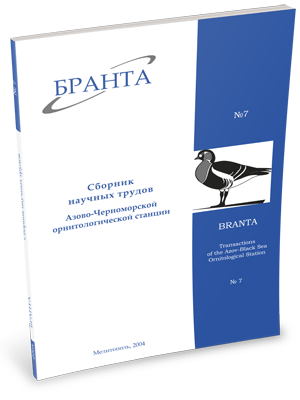
Transactions
of the Azov-Black Sea Ornithological Station



Breeding history and dynamics of colonial settlements of Great Cormorant (Phalacrocorax carbo) in the Black Sea Biosphere Reserve
Rudenko A.G., Yaremchcnko O.A.
This paper presents extended material on the breeding history, biology and role of Great Cormorant (Phalacrocorax carbo) in polyspecies communities of birds on islands of the Black Sea Biosphere Reserve. Reasons of increasing numbers of this species, interspecies relations, and problems of negative effects caused by Great Cormorant on other bird species are analyzed. The long-term data represent number dynamics, structure of colonies, reproductive indices, migrations and wintering. The paper also describes biotechnical measures carried out on the reserved islands in order to decrease the negative impact of Great Cormorant which it brings on breeding of other birds.
The research was carried out in Tendrovsky and Yagorlytsky Bays of the Black Sea and their islands in the territory of the Black Sea Biosphere Reserve from 1984 to 2004.
Over the last 10-15 years in the Azov-Black Sea region numbers of Great Cormorants are markedly increasing. Since 1986-1989 the growth of this bird numbers has taken the form of explosion. And it resulted in mass reallocation of breeding birds in the Black Sea region. In 1989 the colony of Great Cormorants was recorded on Bolshoy Konsky Island in Yagorlytsky Bay of the Black Sea. It was the first registered breeding of Great Cormorants on the reserved islands. For the second year of breeding the number of birds increased twice. Since 1993 a new growth in number was registered. The total Cormorant numbers on Tendrovsky and Yagorlytsky Bays for the last years show about 2,000-4,500 breeding pairs (Figure 1, 2).
The Great Cormorant breeds on two types of islands (of continental and alluvial origin). Bird colonies are located on elevated flat platforms, at height not less 0.3-0.5 m above sea level. Vegetation of such sites is halophytic with predominance of Salicomia europaea, Limonium Meyeri, Puccinellia fominii. Birds very frequently take sites of islands which are covered with Phragmites communis, Artemisia sp., Atriplex tatarica, Tripholium pannonicum and Sisymbrium cojhia.
Average annual date of the first laying of eggs is 28.03+2 (STD=7.7; CV % = 17.6; n=13 years). Periods of laying eggs depend on weather conditions in a year and biotechnical measures carried out on the islands. The clutches consist of 1-7 eggs, but chiefly there are nests with 3-5 eggs (Table 2). The average size of clutches according to the data of annual observations is not large and equals 3.4+0.1 (STD = 0.32; CV % = 9.4; n=13 years). The minimum size of clutches was registered in 1991, when nests contained 2.9 eggs, maxima size in 1999 with 3.9 eggs in nests. The total breeding success in the reserve is low and shows 0.8-2.7 fledged chicks per one nest (Table 3).
On appearing Great Cormorant - a new species in the settled breeding community - on the islands of the Black Sea Reserve new forms of interspecies interaction rose among birds. Some species abandoned the islands or their numbers dropped, other species changed their breeding habitats. Interspecies relations between Great Cormorant and other breeding bird species on the islands are now in the process of development. The Cormorant causes both positive and negative effects on islands omithocomplexes. However it is already clear that the negative effect predominates.
In accordance with the environmental laws of Ukraine and numerous international conventions the colonies of Cormorants are protected in the Black Sea Biosphere Reserve, though this species is considered as an undesirable member of insular complexes. Great Cormorant produces negative moments on islands of the Reserve. Being attractive for such an aggressive species as Yellow-legged Gull (Larus cachinnans) and Grey Heron (Ardea cinerea), Great Cormorant is the clear reason of mass cases of predation provided by yellow-legged gulls and herons in colonies of Mediterranean Gull (Larus melanocephalus), Slender-billed Gull (L. genei), and terns. Colonial settlements of birds of European importance are subject to irreparable injury. As it was mentioned above, Great Cormorant is a strong territorial competitor, and while its number increases the situation on islands is worsening.
In connection with this fact biotechnical measures are provided on the territory of the reserve in order to cut down negative impact of the Great Cormorant on insular omithocomplexes.
Read the paper in a PDF file